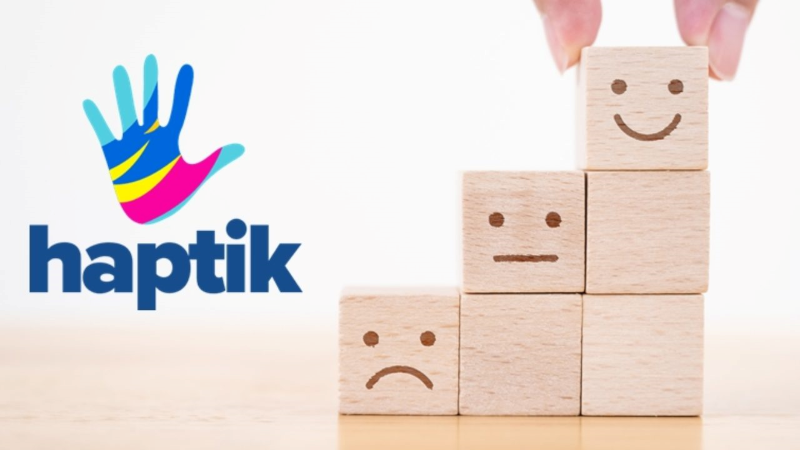Haptik, launched in 2014, is India’s first personal-assistant app. Smartphone-owners download the Haptik app, which features artificial intelligence, from the Apple App Store or Google Play Store onto their devices. Users of the app can plan travel, check-in for flights, book taxis, and set travel reminders. Through the reminders feature, users will receive calls from a Haptik team member at a requested time, relating the reminder message. Recently, Haptik has started delivering reminders using text-to-speech technology. The latest version of the Haptik app also includes an integrated wallet which enables transactions within the app.

AWS is helping us maintain a monthly user growth rate of more than 30 percent.”
Swapan Rajdev
Co-founder & CTO, Haptik
The Challenge
By the middle of 2017, more than 450 million citizens in India will have access to the Internet, according to the Internet and Mobile Association of India (IAMAI). Of these people, 77 percent living in urban areas and 92 percent living in rural areas will access the Internet using mobile devices, such as smartphones. Looking at these statistics, it’s easy to see why entrepreneurs in India are building businesses around smartphone apps. They see a huge market for these software applications among the millions of Indians with mobile Internet. Indeed, when Haptik launched in 2014, founder and current CEO, Aakrit Vaish, had already identified the potential for his own vision of a personal-assistant app. Says Vaish, “With Indians spending 75 percent of their smartphone time on a text or chat interface, we looked to improve that experience by leveraging technologies such as artificial intelligence and machine-learning for Haptik.”
For customers to gain the improved experience Vaish wanted, IT stakeholders at Haptik thought carefully about the IT infrastructure supporting the company’s software. They discounted an on-premises solution immediately. The upfront capital costs were too high and an on-premises architecture didn’t fit with the company’s broader IT goals. Ranvijay Jamwal, DevOps lead at Haptik, explains, “It wasn’t only upfront costs that steered us away from an on-premises architecture. We were concerned about the IT management time associated with maintaining a highly available on-premises solution. Furthermore, we wanted the kind of scalability not associated with on-premises platforms to handle a growing number of app downloads each month while supporting the rapid development of our services.”
Why Amazon Web Services
In 2014, Haptik looked for a cloud service on which to develop the infrastructure behind its personal-assistant app. The company considered leading cloud providers in the market based on cost, maturity of services, and brands with which they were already working. Jamwal says, “We engaged with AWS because of its cost effectiveness and the breadth of its services. As a company, we were also impressed by the number of well-known brands worldwide using the AWS Cloud.”
Developers at Haptik built the infrastructure behind the Haptik app directly on the AWS Cloud. The software behind the Haptik app runs on Amazon Elastic Compute Cloud (Amazon EC2) instances. Alongside those instances is Amazon Relational Database Service (Amazon RDS), which supports multiple replicated MySQL databases. About 90 percent of the data in Haptik’s databases relates to customers, including data on customers’ use of the app’s services. Haptik has also developed its own machine-learning service, which runs on Amazon EC2 instances as well. As part of that service, Haptik uses Amazon Elasticsearch Service to power its Named Entity Recognition (NER) module which helps detect named entities from a user’s message. Today, the NER module has been open-sourced as the Chatbot NER.
Haptik uses Amazon CloudFront to provide caching of its regularly hit APIs, images, and various types of content, which in turn takes a load off their Amazon EC2 instances. The business also uses Amazon Simple Storage Service (Amazon S3), Standard-Infrequent Access and Reduced Redundancy Storage class to reduce storage costs.
Recently, Haptik incorporated Amazon Polly into the Haptik infrastructure. Amazon Polly turns text into lifelike speech. In effect, it lets developers build applications that can talk. The service also offers dozens of lifelike voices in multiple languages, thus also allowing developers to target audiences in a variety of countries. Says Jamwal, “When we were first introduced to Amazon Polly, we were already using text-to-speech technology. We integrated Amazon Polly into our test environment in less than one day—this is how easy AWS services are to work with. We found the performance of Amazon Polly was better than our previous solution, delivering a more lifelike experience.” Today, Amazon Polly is fully integrated into the Haptik production environment, supporting text-to-speech services within the reminder feature of the app.
The Benefits
Using AWS, Haptik avoided upfront costs of an on-premises solution. Over time, the company has also seen its IT savings increase thanks to innovations such as Amazon EC2 Spot Instances. The service allows AWS customers to bid on spare Amazon EC2 computing capacity. “We have reduced our compute costs by around 50 percent by using Amazon EC2 Spot Instances,” says Jamwal.
Haptik is also seeing 99.999 percent availability from its cloud infrastructure, ensuring Haptik customers have the best user experience from the app. In addition, Haptik has achieved this level of uptime at less management expense that an on-premises solution. Jamwal says, “If you compare the AWS Cloud with an on-premises infrastructure, you can gain a high level of uptime with 80 percent less management expense.”
Jamwal has no concerns that management time will increase as the AWS infrastructure grows. Currently, the number of app downloads is increasing month-on-month as more Indians choose Haptik as their personal assistant and as Haptik continues to develop its service. “AWS is helping us maintain a monthly user growth rate of more than 30%,” says Swapan Rajdev, co-founder and CTO of Haptik. “We’re achieving this rate of increase without additional IT management time while ensuring we have the agility to drive the development of our service to maximize customer loyalty and attract new customers.”

